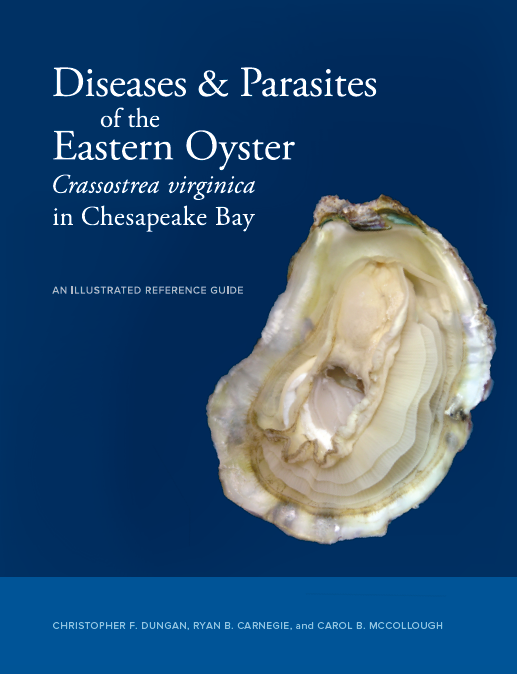Diseases & Parasites of the Eastern Oyster, Crassostrea virginica, in Chesapeake Bay: An Illustrated Reference Guide
Author(s):
Christopher F. Dungan, Ryan B. Carnegie, and Carol B. McColloughYear Published:
2020Product ID:
UM-SG-TS-2020-01Publisher:
Maryland Sea GrantPrice:
$34.95Page Count:
126 pagesReviews
From David Bushek, PhD
Professor of Marine and Coastal Sciences
Director, Haskin Shellfish Research Laboratory
Rutgers, The State University of New JerseySeveral things are particularly well done. First, there is a nice introductory chapter that provides an easy entry for those not familiar with the oyster, its anatomy and the basics of histopathology. Second, the images and respective descriptions in most chapters are very well done. They provide crisp images that clearly illustrate structures and diagnostic features. Third, the chapters are well organized into a consistent format that makes them easy to follow and easy to find information quickly. Finally, the chapters create a comprehensive description of the histopathology of the eastern oyster providing a wealth of information that previously required multiple disparate resources.
From Tal Ben Horin, PhD
Assistant Professor of Shellfish Pathology
North Carolina State University Department of Clinical SciencesOur copy now lives on the microscope table in my lab, and it's pretty typical for the students rotating through my lab to find themselves deep in that book whenever at the microscope these days. Me too. The text gives just enough detail even for a general audience with basic anatomy background. The images are the real draw though. It’s a tremendous resource for anyone working on pathogen and disease issues in oysters—students, faculty, environmental consultants and managers included.
Description:
This is a comprehensive, color-illustrated guide to histological presentations of diseases, pathogens, and parasites of eastern oysters, Crassostrea virginica.
It includes 18 subject chapters and more than 100 color figures and diagrams
Soft cover, 126 pages, 8.5 x 11 in.
This publication supports the development of oyster aquaculture industries and restored populations of wild oysters in the eastern United States. Both aquaculture and efforts to restore the eastern oyster, Crassostrea virginica, have expanded in recent years, increasing the need for a broader understanding of oyster health. This volume addresses that need by providing detailed information on the histological presentation of diseases and parasites affecting eastern oysters.
Oyster aquaculture has rapidly developed in the Chesapeake Bay region because of new efforts by entrepreneurs and changes in state policies that make it easier for aquaculture operators to obtain leases. Virginia has the largest oyster industry on the United States Atlantic coast, which is largely driven by aquaculture. This cultivation is also expanding in other regions in the United States. As with all forms of animal husbandry, success in oyster aquaculture relies on close attention to diseases in order to prevent or mitigate serious impacts on production and survival. This guide is meant to help maintain the disease biosecurity of oysters grown or harvested from Chesapeake Bay and elsewhere.
This volume is also intended to inform health assessments and protection of wild oysters that share habitat waters and microbial associates with cultured oysters. State agencies must pay close attention to disease events in both wild oyster populations that they manage and in cultured oyster populations that they strive to protect. Natural resource management agencies of both state and federal governments regulate transfers of oysters within and between their jurisdictions to prevent introduction and transfers of exotic oyster pathogens and to prevent exacerbation of endemic diseases. Permits for such transfers routinely require formal reports on the results of health inspections or pathological examinations of shell stocks proposed for transfer.
CONTENTS
INTRODUCTION
Chapter 1: Histological Microanatomy
DISEASES AND CONDITIONS CAUSED BY PROTISTS
Chapter 2: Perkinsus marinus Infections (Dermo Disease)
Chapter 3: Haplosporidium nelsoni (MSX)
Chapter 4: Haplosporidium costale (SSO)
Chapter 5: Bonamia exitiosa
Chapter 6: Ciliate Associates
Chapter 7: Hexamita and Other Diplomonad Flagellates
Chapter 8: Apicomplexan Parasites
DISEASES AND CONDITIONS CAUSED BY METAZOA
Chapter 9: Nematode Parasites
Chapter 10: Trematode Parasites
Chapter 11: Cestodes
Chapter 12: Turbellaria
Chapter 13: Crustacea
DISEASES AND CONDITIONS CAUSED BY BACTERIA AND VIRUSES
Chapter 14: Viral Gametocytic Hypertrophy
Chapter 15: Bacterial Infections and Associates
PROLIFERATIVE DISORDERS
Chapter 16: Disseminated Neoplasia
Chapter 17: Germinomas and Other Solid Tumors
OTHER DISEASES AND PARASITES
Chapter 18: Less-known Pathogens and Associates




